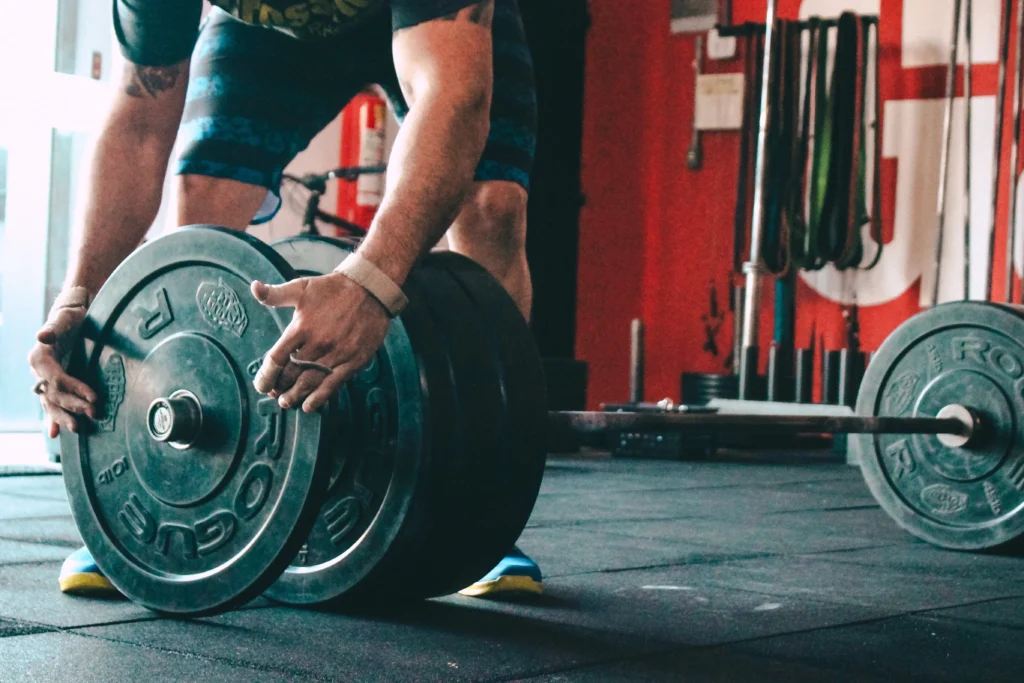Free Shipping On All Orders
Garage Gym Workouts 2024: 3 effective Ways To Build Your Workout Week

We know how important it is to stay fit and maintain a workout routine. With busy schedules, gym memberships, and crowded gym spaces, it’s no wonder that garage gym workouts are becoming more and more popular, espacially during the Covid times.
Understanding Garage Gym Workouts
When it comes to equipment for garage gym workouts, there are a few essentials to consider. Initially, you’ll need 1-2 mats for floor exercises, a set of adjustable dumbbells, and ample space to move around comfortably – about a 6’x2′ area is recommended. You may want to add equipment such as a squat rack, bench press, and kettlebells to vary your routine and keep challenging yourself.
There are plenty of workout programs available to suit your garage gym setting. From CrossFit to a 5-day garage gym workout program, you can find routines that suit your fitness goals and interests. By combining a mix of aerobic exercise, bodyweight exercises, and Olympic weightlifting, these programs aim to improve your cardiovascular endurance, strength, and overall physical fitness.
Beginning Your Garage Gym Workout

It’s important to have the right equipment for your garage gym. A solid strength training set-up should include essentials like a power rack or squat stand, weight plates, a flat bench, a barbell, and possibly a deadlift platform. With this equipment, you can engage in exercises like squats, deadlifts, bench press, overhead shoulder press, and pull-ups.
In addition to strength training, consider incorporating CrossFit elements into your garage gym workouts. This well-rounded program aims to improve cardiovascular endurance, stamina, power, flexibility, strength, speed, and coordination. It combines aerobic exercises, bodyweight exercises, and Olympic weightlifting, adding variety and keeping your workouts fresh.
Another approach to garage gym workouts is following a 5-day workout program, focusing on efficiency. Such programs often target different muscle groups each day, ensuring a balanced and comprehensive workout routine.
Don’t be afraid to include beginner-friendly, barbell-based exercises in your garage gym workouts. These exercises help build a strong foundation for strength training and ensure proper form and safety. Make sure you start slow, gradually increasing weights and the difficulty level as you progress.
For more information on Garage Gym equipment check out our in depth guide on Garage Gyms!
Sectional Breakdown Of Workouts
Upper Body Workouts

When it comes to building strength and muscle in the upper body, a great place to start is with push-ups, pull-ups, and bench presses. Rotate these core exercises into your garage gym routine for an effective and efficient upper body workout.
- Push-ups: Classic bodyweight movement targeting the chest, shoulders, and triceps.
- Pull-ups: Focuses on the back and biceps muscle groups.
- Bench Press: A staple weight-lifting exercise for the chest and triceps.
Additionally, consider exercises such as dumbbell presses, dips, and rows to really target all the major muscle groups in your upper body.
Lower Body Workouts

For a solid lower body workout, some exercises you can include in your garage gym regimen are squats, lunges, and deadlifts. These exercises are excellent for targeting the glutes, quads, and hamstrings.
- Squats: The foundation of lower body strength training, hitting quads, glutes, and hamstrings.
- Lunges: A versatile exercise for training the entire lower body and improving balance.
- Deadlifts: A powerful compound lift for total body strength, especially engaging the posterior chain muscles.
To round out your lower body workout, consider adding in kettlebell swings and weighted step-ups.
Full Body Workouts
Full body workouts are a fantastic way to maximize your time in the gym and target every major muscle group in a single session. Some garage gym workout suggestions to achieve this include the following exercises:
- Burpees: A dynamic bodyweight exercise that gets your heart rate up and targets multiple muscle groups.
- Kettlebell Swings: Engages both the upper and lower body, while also providing a great cardiovascular workout.
- Clean and Press: A full body exercise that tests your skill, strength, and mobility – working on your legs, hips, back, shoulders, and arms.
You can also look after a one machine fits all solution for the beginning. I suggest you take a look on the Weider XRS 50 Home Gym or the Weider 8530 Home Gym.
Mix and match these exercises to create your full body garage gym workout that suits your individual needs and goals. Happy training!
Creating A Weekly Workout Plan
Balancing Workout Intensity
To optimize your garage gym workouts, it’s important to strike the right balance between workout intensity and variety. Incorporate both high-intensity and low-intensity exercises, such as strength training and cardiovascular workouts, to keep your body challenged and engaged on different levels. Remember, short and intense sessions are just as effective as longer, moderate ones.
Here are some ideas for balancing workout intensity in your garage gym:
- Alternate between strength and cardio days, focusing on different muscle groups
- Mix up isolation and compound movements to target multiple muscle groups
- Incorporate HIIT (high-intensity interval training) and LIIT (low-intensity interval training) sessions
Rest and Recovery Days
Don’t forget to designate rest days in your weekly workout plan. Giving your body time to recover is essential for preventing injuries and optimizing long-term progress. Rest days can be either complete rest or active recovery, such as light stretching, yoga, or low-intensity activities like walking.
We recommend following these guidelines:
- Schedule one to two rest days per week, depending on your fitness level and goals
- Space them evenly throughout the week
- Listen to your body and adjust rest days as needed
Incorporating these considerations into your weekly workout plan will help ensure that your garage gym workouts are effective, sustainable, and most importantly, enjoyable. There is nothing wrong with doing something just for fun.
Include Variety in Garage Gym Workouts
We all know that incorporating variety in our garage gym workouts keeps things fresh and helps us stay motivated. In this section, we’ll explore two ways to include variety in your training: using different equipment and mixing workout styles.
Using Different Equipment

One way to keep your garage gym workouts exciting is by introducing new equipment into your routine. You don’t need to spend a fortune on expensive gear; even small investments can make a big impact. For example, consider incorporating resistance bands or kettlebells as alternatives to your usual dumbbells and barbells.
Mixing Workout Styles
Another great way to add variety to your garage gym workouts is by mixing workout styles. This can mean alternating between strength training and cardio-focused sessions or even incorporating elements from different disciplines, such as yoga, boxing, or HIIT.
For instance, you might spend one day focusing on weightlifting and compound exercises, followed by a day of cardio – whether it be running, cycling, or jumping rope. Adding yoga or mobility training on your rest days can also aid in recovery and enhance flexibility.
Maintaining Consistency in Garage Gym Workouts
We all know how crucial consistency is when it comes to working out. Garage gym workouts are no exception to this rule. In fact, maintaining a routine with regular exercise sessions can sometimes be even more challenging in a home-based gym. Let us explore a few ways to ensure that we stay on track with our fitness goals within the comfort of our garage gyms.
It’s essential to pick the same time of day to work out, no matter what. This helps establish a consistent habit while ensuring our bodies adapt to the exercise routine. For example, if 9 am works for you, it is crucial to commit to working out at that time every day.
Next, it’s imperative to have a well-structured, 5-day workout program that is designed to target different muscle groups. This not only helps us see improvements in our physique but also keeps the workouts engaging and enjoyable.
Setting up a dedicated exercise space in the garage is crucial for fostering consistency. Ensure you have the necessary equipment and enough space to move around comfortably. A 6’x2′ area with mats and dumbbells can make a significant difference in helping you commit to your garage gym workouts.
Tracking progress is essential for consistency. Keep a workout journal, log your weight and measurements, and maintain a record of your exercises, sets, and reps. This enables you to monitor your improvements and highlights areas where you need to focus more. I like google sheets but every other excel or even a book is doing the job.
Safety Tips for Garage Gym Workouts

Never skip your warm-up and cool-down routines. Warming up helps prepare your body for the exercises and can prevent injuries, while cooling down aids in muscle recovery. Take about 5 to 10 minutes for each part of your routine.
Always prioritize proper exercise technique. Incorrect form can lead to injuries and reduce the effectiveness of your workouts. If you’re unsure about your form, consult a personal trainer or watch instructional videos for guidance. You can also contact us for help.
Another key safety tip is to gradually increase your workout intensity. Trying to do too much too soon can lead to injuries and burnout. Instead, focus on consistent, gradual progress. This approach will help ensure that you’re staying safe and maximizing your results.
You can think about working out with a training partner from your neighbourhood. It’s more challenging pushing those weights together. Plus, it’s more save if your training partner can look after you during your Garage Gym Workouts.
Tracking Your Progress
Establish your goals and set measurable milestones. Whether it’s increasing your squat max or completing a certain number of workouts per week, having clear targets will instill a sense of purpose and direction in your garage gym workouts.
Don’t forget to focus on both qualitative and quantitative aspects of your training. Record your weights, repetitions, and sets but also take note of how you feel during the workout, your energy levels, and overall mood. This complete picture will allow you to better understand the connection between your workouts and your body’s response.
Celebrate your achievements, big or small! As you reach milestones or progressively improve your performance, acknowledge your hard work, and reward yourself. This will not only boost your motivation but also reinforce your dedication to your garage gym workouts and overall fitness journey.
FAQ
What basic equipment is needed for a garage gym?
To get started with your garage gym workouts, you’ll need some basic equipment like a power rack or squat stand, weight plates, a flat bench (adjustable), a barbell, and a decent amount of space to move around. Optional equipment includes a deadlift platform, dumbbells, and a plyo box.
Can I do a full-body workout in my garage gym?
Absolutely! A garage gym can be an excellent space for a full-body workout. By incorporating a mix of compound movements (like squats, deadlifts, and bench press) and bodyweight exercises (like pull-ups, push-ups, and burpees), you can target all major muscle groups to build strength and endurance.
How can I create a workout routine suitable for my garage gym?
Designing a workout routine for your garage gym is simple. Start by setting clear goals (strength, endurance, or weight loss), then select exercises that target your desired muscle groups. Structure your workouts by focusing on compound exercises first, followed by isolation exercises and finish with a cool-down stretch. To keep things fresh and challenging, vary your exercises and workout durations regularly. Remember to always prioritize proper form and safety.
Do you love Garage Gym Workouts just as we do? Let us know in the comments and keep growing!

